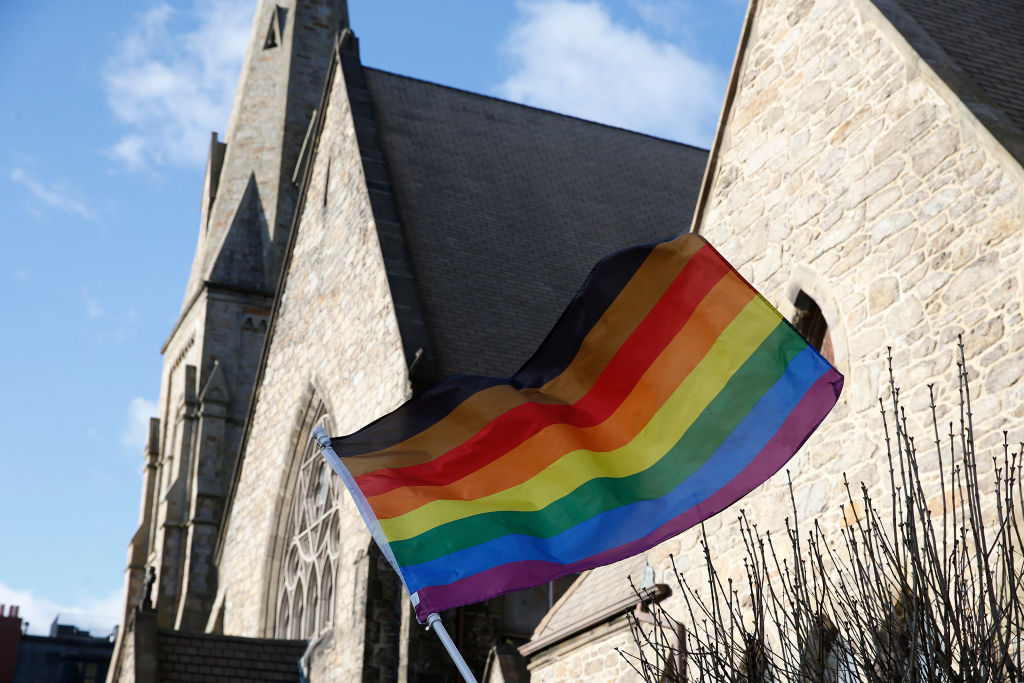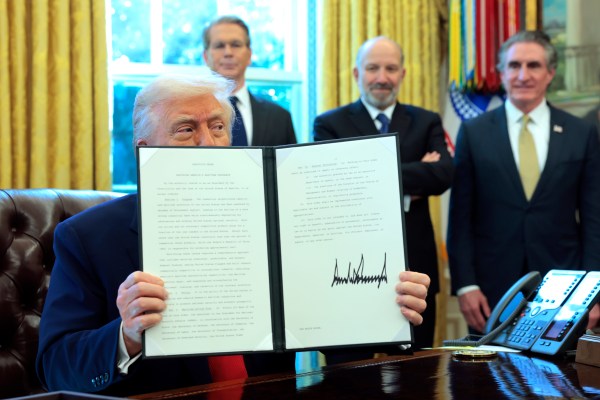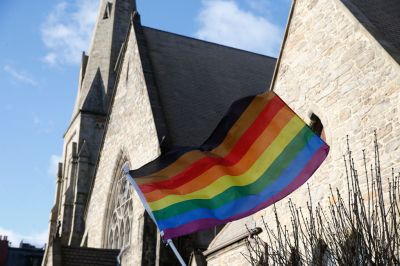Back in 1969, approximately 11 million believers belonged to the United Methodist Church, making it the third-largest religious body in the United States after Roman Catholics and Southern Baptists. Yet over the following decades, the denomination—like many others in America—dwindled. Then, between 2019 and 2023, the church split, largely due to disputes over its teachings on gender and sexuality.
Leaders of the United Methodist Church are gathering this week and next in Charlotte, North Carolina, for the international General Conference. They will almost certainly liberalize the church’s teachings on the very topics that led to its schism. But while it will continue to lose members, the decline of the United Methodist Church isn’t just indicative of trends in American liberal Protestantism. Rather, it’s a telling sign of a wider institutional demise of denominationalism across the nation.
For decades—as mainline Protestant denominations like the Episcopal Church and the Presbyterian Church (USA) liberalized their policies to affirm same-sex marriage and gay clergy—United Methodist traditionalists won all the legislative votes regarding its teachings on sexuality. But their victory was in part due to their church’s unique international membership: Delegates from growing congregations in Africa consistently sided with U.S. traditionalists. In 2019, at a special governing General Conference, 53 percent of United Methodist delegates reaffirmed the church’s affirmation of sex only within marriage between a husband and a wife.
Those legislative wins did not change the overwhelmingly progressive bent of the United Methodist leadership, including among bishops, church agencies, seminaries, and most clergy. So after the 2019 General Conference victory, traditionalists realized their best option was to take advantage of a temporary policy allowing them to leave the church after a two-thirds congregational vote and an often-hefty exit fee. Then in December 2023, the United Methodist Church concluded a four-year process that allowed conservative congregations to quit the denomination without forfeiting their property (which the denomination typically holds). Over 7,600 congregations—25 percent of the U.S. total, or about 1.5 million members—left. When taking their departure into account, the United Methodist Church now likely has approximately 4 million members.
With many, if not most, U.S. conservatives gone, the present United Methodism’s governing international General Conference will likely shift the church sharply to the left. Teachings and policies affirming traditional Christian teaching on marriage and sex will easily fall. A legislative committee has even removed adultery as a chargeable offense for clergy. Perhaps personal pronoun identification will be expected among the delegates. Land acknowledgments and how to conduct them have already been discussed. The denomination may revert to its 1970s hardline abortion rights advocacy. (In 2016 the church finally withdrew from the Religious Coalition for Reproductive Choice it had helped found in 1973.) Many remaining U.S. United Methodist conservatives will be aghast as they read reports, but there will be little they can do besides quit the denomination or tolerate it becoming increasingly progressive.
That’s not to say there’s no dissent to the denomination’s leftward swing. United Methodism’s only growing regions are in Africa, where the churches are overwhelmingly conservative. African church members outnumber U.S. church members, but the delegate formula assigns Africans only 34 percent of the total. Africans also face travel hurdles, with dozens of delegates typically failing to get U.S. visas. This year, over 70 out of 278 African delegates, or 25 percent, failed to get visas, more than twice the usual rate in the past for such delegates.
Though Africans will vote nearly unanimously against changing the church’s teachings on sexuality, they will have far fewer U.S. allies this time—and they’ll lose as a result. Will they march out of the General Conference in protest? Will they quit United Methodism altogether? U.S. church officials are pushing a “regionalization” plan that would omit Africa from U.S. church liberalization. Many African bishops, who depend on U.S. dollars, support it. But I doubt most Africans will be persuaded. Ultimately, millions of Africans will likely quit United Methodism, leaving the denomination as a near U.S.-only progressive rump.
Dwindling membership will also raise financial challenges for the denomination. The typical U.S. United Methodist, as with other mainline Protestant denominations, is an older white person. A 2015 Pew Research Center study found 96 percent of United Methodists are white and 62 percent are over age 50. Although many aging church members have financial means and are generous, the denomination is preparing for a sharp financial downturn. Originally church officials expected that a $604 million quadrennial budget would be approved at the General Conference. But now the proposal is reduced to $346.7 million, or a 43 percent cut.
National church agencies will be slashed. The church is considering eliminating 17 out of 66 international bishop slots. Even these sharp cuts might not sufficiently account for the unfolding tsunami in church demographics, compounded by the pandemic’s impact on church attendance and collapsing denominational loyalties even among churchgoing Americans.
Many Methodists (myself included) descend from generations of Methodist ancestors. But Americans under the age of 60 are increasingly indifferent to where their grandparents worshipped. Nearly all denominations in America are declining, liberal and conservative, although the liberal ones have declined far longer and more dramatically. Even some denominational congregations, especially if successful with younger members, hide their denominational affiliation. The only major growth area in American Christianity is among nondenominational churches.
Which raises the question: What will happen to the over 7,670 U.S. churches that quit United Methodism? Over 4,000 have so far joined the new Global Methodist Church (GMC), which is committed to traditional Christian theology and ethics, including sexuality. Perhaps as many as 5,000-6,000 churches ultimately will join the GMC, whose convening General Conference will meet in San José, Costa Rica, this September. (International delegates will have an easier time getting visas to Costa Rica than to the U.S.) There, delegates will set the rules governing the new denomination.
But the GMC will be a different kind of denomination. Under rules likely to be ratified, congregations will own their church property, have more authority over their pastoral appointments, and have small payments to the denomination. The GMC won’t have big church agencies or its own seminaries. Congregations will support their own mission projects. Synced with trends in American Christianity, the GMC will be more of a network of churches instead of an old-style denomination.
The old style of U.S. Protestant denominations included at least hundreds of thousands of members bound in a common intergenerational subculture. They were supported by mission agencies, book publishers, journals, seminaries, colleges, political lobby offices, and national church leaders who were often renowned beyond their own community. Whether United Methodist or Southern Baptist, this concept of denomination is fast fading.
Growing nondenominational Christianity in America, by contrast, is comprised of independent congregations, founded by entrepreneurial pastors who pick their own study materials, church governing mode, and theological emphases. They are usually contemporary in worship, having praise bands instead of choirs and hymns. Their prayers are spontaneous rather than liturgical. They quote the Bible but maybe not the ancient church creeds or the Lord’s Prayer. Their sermons are often long and very practical. They stress the Bible but often pretend that church tradition is not important.
These nondenominational churches fill an urgent spiritual need in America. However, they often depend on charismatic pastors and struggle to survive pastoral successions or congregational controversies. They surround most cities, often building massive suburban buildings and parking lots. But can they survive their first and second generations, in the way that denominational churches often survived for centuries?
Methodism has endured nearly 300 years, starting with the revivals led by Church of England evangelist John Wesley. It surged to become America's largest church early in the 19th century and, like United Methodism or predecessor bodies, it remained America’s largest Protestant church for most of the 20th century. Its demise, along with the rest of liberalized mainline Protestantism, was mostly self-inflicted. Liberal theology and politics displaced orthodox doctrine, evangelism, and exacting spiritual standards.
Conservative denominations, like the Southern Baptists, displaced the old liberal denominations, but now they are stalled or declining. The new Global Methodist Church might, if successful, offer a new model of church network with accountability and community without stifling, sclerotic bureaucracy. Most nondenominational Christianity today is Calvinist and/or Baptist in theology and ethos, believing in some form of predestination and rejecting infant baptism. Methodism has its own distinctions, which include Arminian theology (salvation available to all who ask), infant baptism, liturgy, a stress on personal holiness, an egalitarian spirit, optimism, and a preference for practicality over abstract doctrine. In the marketplace of religious ideas in America, Methodism should be able to hold its own.
Methodism’s role in Christian political witness and activism, long dominated by Baptist-inclined evangelicals, might also be important. Whether liberal or conservative, Methodism dating to John Wesley has always stressed reforming society. Care for the nation is embedded into Methodism’s DNA, thanks to its roots in the Church of England and its prominence in shaping early American democracy. Methodist perfectionism can lead to fruitless political crusades like Prohibition.
But the best of Methodist social engagement and political theology might offer a calming sensibility to frenetic evangelical political engagement. Methodism usually tends towards practicality, moderation, optimism, and patience. In polarized America, a renewed Methodism that’s confident about America, and even more confident in God, would be much welcome.





Please note that we at The Dispatch hold ourselves, our work, and our commenters to a higher standard than other places on the internet. We welcome comments that foster genuine debate or discussion—including comments critical of us or our work—but responses that include ad hominem attacks on fellow Dispatch members or are intended to stoke fear and anger may be moderated.
With your membership, you only have the ability to comment on The Morning Dispatch articles. Consider upgrading to join the conversation everywhere.